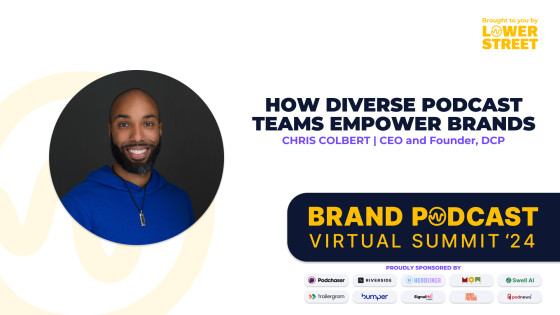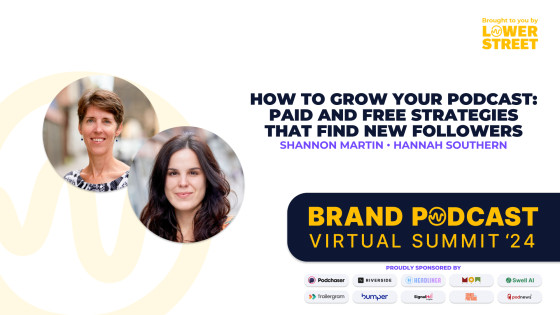Spot the Trend, Know Your Audience, and Make Content They Love
Contents

This is the question that Steph Smith, host of a16z podcast and founder of Internet Pipes, posed to us all at the Brand Podcast Summit.
As all good marketers know and claim: your audience is the most important, know them, understand them, and you’ll know how to make the product they need. But while we repeat this over and over again, it’s time to be honest. Sometimes we create content based on what we think our audience wants, but it can be far out of the field.
If that’s the case, how can we really, truly understand what our audience wants us to talk about?
The answer is by growing our trending toolbox. Follow trends, and follow conversations across the internet in order to know the content they want.
So many people are already online, telling us what they want. It may be directly, or through their habits. Thanks to the internet, we can see and know all this data.
What makes your podcast content different?
Podcasts are still a relatively new content form, but they have so much potential for connection with our audience. Podcasts act as your best friend, they’re a voice in your ear, and you spend a lot of time with the few that make it into your circle.
To succeed at making it into that circle, podcasts need to be much more emotionally resonant.
How You Can Make a Show That Can Grow
Harry Morton and Jonas Woost also joined the Brand Podcast Summit to remind us that if you want to grow your show, you need to focus on making better content for your audience.
Before you start looking at growth strategies, to set yourself up for success from the start, you need to focus on your content. In the world of podcasts, the key to success often hinges not just on attracting more listeners but on crafting a show that genuinely resonates with your audience. That means, talking about what they want to hear about.
It sounds simple, but it’s often overlooked, a podcast needs to serve its intended audience. This is the very first strategy to podcast success, then you can talk about expanding reach.
Creating a podcast isn't just about having great content or top-notch production—it's about fulfilling the needs and expectations of the listeners you want to connect with. This approach shifts the focus from a mere numbers game to building a meaningful relationship with your audience.
Understanding and Connecting with Your Target Audience
Here's a breakdown of how podcasters can align their content with the needs of their listeners:
Identify Your Core Audience
Not your target, your core. Those who will most likely engage deeply with your content. This segment includes listeners who, upon finding your podcast, will feel it's tailor-made for them. Understanding this group helps in crafting highly relevant content that engages potential loyal fans.
Expanding Your Audience Reach
Expanding beyond your core audience means appealing to “adjacent” and “transformational” audiences. These are groups that might benefit from your podcast in different ways, offering opportunities to broaden your listener base without diluting the essence of your content.
Adjacent Audiences: listeners who are connected to your core audience but might engage with the podcast for different reasons. Their connection to the content is one step removed from the core but still relevant.
Transformational Audiences: The largest and most diverse group. Transformational audiences may find value in the broader themes or entertaining qualities of your podcast. Appealing to this group requires balancing general appeal with specific, engaging content that resonates on a larger level.
Deliver What Promises
Each audience segment comes with different expectations and needs. You’ll want to make and deliver clear promises to each group. This not only enhances the relevance of the content but also ensures that your future growth strategies are aligned.
So where do we find data on what audiences want to talk about?
Find your Data
So much data that you wanted to know is already within reach. You can see:
• what products people are buying and the scale (use Jungle Scout)
• what content trends are catching on (Keywords Everywhere)
• how localized these trends are (Google Trends)
• questions people are asking in unique corners of the web (Answer the Public)
But that’s just the surface, here are some more tools that Steph shared, and the power they have to find trends within your audience.
The Power of Reddit
You know the big picture, what your audience talks about overall. Let’s say it’s technology, in general. But to make quality content that they really want to know about, use the power of Reddit.
Anvaka Sayit is a tool that creates a knowledge map of Subreddits. Meaning that you can see all the sub-ideas that your audience is interested in or talking about. This tool makes sense of how millions of active users and subreddits are connected.
Using Reddit as a base for your data search, you can also use a similar tool called Map of Reddit.
But what can all this data tell us, in terms of what we want to know?
If you want to know how many people care about a topic, therefore deciding how much of a reach your content could have, look at the size and engagement of subreddits.
If you want to see the trend of information, see if more people care about a topic with time, and look at the growth rate of the communities.
Want to know the most pressing questions and problems your audience experiences? Look at the most upvoted posts in the relevant subreddits.
Keep an eye on SEO
Looking at your keyword trends or search trends you can find out a lot about your audience, or your podcast topic.
Think you’ve got a common problem to talk about? Find out how many people share this challenge by looking at the number of searches per month.
What solution would resonate with your audience? What do they want to hear? Look at the intent of the results appearing on the page.
What else is your audience struggling with? Look at the secondary related keywords.
When should you talk about this? What are the nuances of this problem, and when/where do people need it? Look at the seasonality and localization of the searches.
Do other Podcasts address this?
If you are trying to determine if your content would resonate with podcast listeners, you can see if it’s been addressed by other shows, and how it was received.
The tool Podengine lets you search by question or specific topic. Results will give you episodes that discuss this. You can check what others are saying, either for research or for judging if the content topic would stand out.
Where do trends come from?
Staying ahead of trends, we might want to look for the origin of trends. How can we see things before they happen?
We can keep an eye on what our audience is talking about and be ready for what might spark their interest. But sometimes we may be caught off guard.
Sometimes a trend takes off because of social media before anyone’s searching for it.
Sometimes a change to an app changes the behavior of the masses, resulting in unexpected behavior.
Sometimes a community is the seed for a movement.
-Steph Smith
Final Thoughts
Overall, the lesson we have learned is to know what your audience is actually looking for, not what your intuition tells you. How do you find this out? Use all the tools and data available to suss out what your audience is talking about, what they are interested in, and what trends they follow. Stay ahead so that you can create content that resonates with them.
Both Steph Smith’s talk, the workshop Make A Show You Can Grow with Harry Morton and Jonas Woost and all sessions of the Brand Podcast Summit are available as replays. You can purchase them here.
We’ll be back next year for even more conversation about brand podcast growth. Keep your eye out for upcoming details.
Thinking about launching a podcast for your brand?
If you need a hand launching, producing, or promoting your branded podcast, the Lower Street team is here to help. Get in touch for a free consultation.
Contact us



